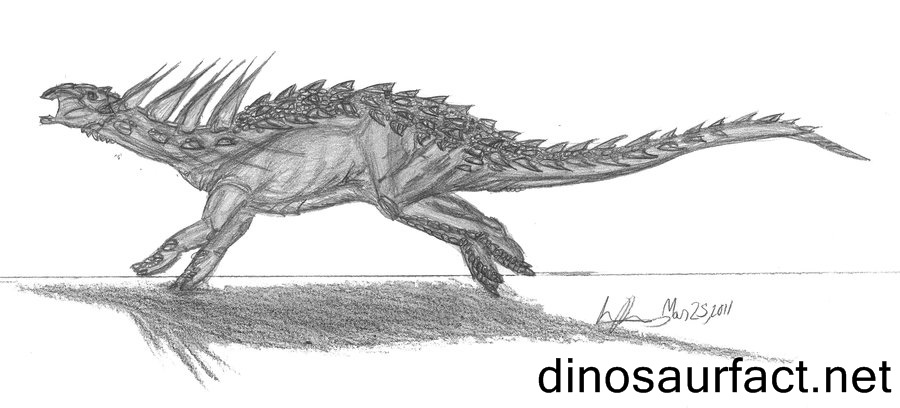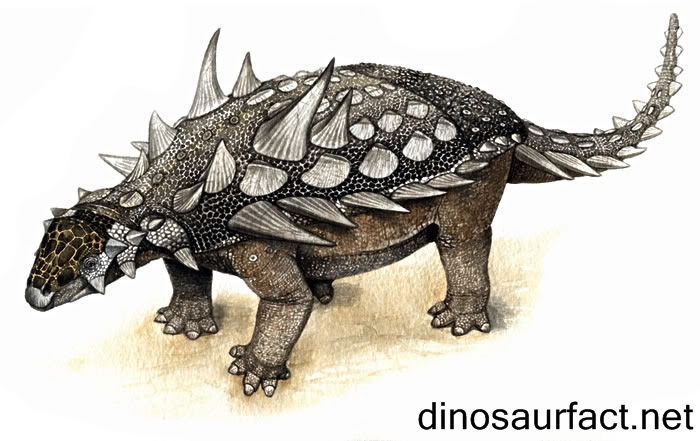 Click to visit the previous dinosaur bio
Click to visit the previous dinosaur bio
 |
|
 |
|
Kingdom: Animalia
Phylum: Chordata
SuperOrder: Dinosauria
Order: Ornithischia
SubOrder: Ankylosauria
Family: Nodosauridae
Genus: Animantarx
 |
|
 |
|
 |
|

The Animantarx was dinosaur that was present on the earth in the middle to late Cretaceous Period of the Mesozoic Era. It was existent in the Albian to the Cenomian ages, about 105 to 98 million years ago. It is an Ankylosaurian dinosaur that is further divided into a nodosaurid. Very little fossils evidence is available about this reptile, but other nodosaurids are well defined, and information about them is extrapolated to the Animantarx.
The size of this creature is difficult to know for sure, but based on comparisons with other similar dinosaurs, the Animantarx is believed to be 3 meters long. Mass is inherently problematic to estimate, even with the help of bony fossils. So in the case of the Animantarx, it is impossible to do anything apart from making a calculated guess; its weight could have been about 500 to 700 kilos. The identifying feature of all nodosaurids and also ankylosaurians is their strong exoskeleton. The Animantarx is believed to share this feature of armored plates with its counterparts.
The fossils of this dinosaur were discovered in the United States in Utah. But considering the fact that nodosaurids were present all throughout North America, Asia and Europe, scientists believe that it could have had a widespread area of occurrence.
Nomenclature
Paleontologist R. S. Lull had described ankylosaurians as ‘animated citadels’, due to their natural fortification with bony scales. The name ‘Animantarx’ is inspired from that comment.
‘Animatus’ is a Latin word and it translates to ‘alive’ in English. ‘Arx’ is again the Latin word for a ‘castle’ or a ‘citadel’. Thus, the name Animantarx is meant to denote a ‘living fortress’ or an ‘animated citadel’ as Lull had framed it.
The binomial name A. ramaljonesi is derived from Ramal Jones, the discoverer of the fossils that were eventually described as the Animantarx. The christening of this dinosaur was performed by paleontologist Kenneth Carpenter in the year 1999.
Discovery of fossils
The remains of the Animantarx were a fortuitous discovery. Ramal Jones, a radiologist at the University, was scanning the Mussentuchit Member of the Cedar Mountain Formation for regions showing higher than normal radioactivity. The bones of this dinosaur were picked up on his scintillometer and that was how he found them. Now this most certainly means that the remains of the Animantarx are radioactive and one cannot help but wonder how did scientists risk studying them. But they were more radioactive than their surroundings and not so much as to cause any harm to human life.
Nature of fossils
The bones that are ascribed today to the Animantarx are but fragmentary and most of them cannot be used for diagnostic purposes.
- The holotype included parts of the skull. These comprised of the posterior cranial bones and the mandible. The occipital was highly domed and the temporal bones had pointed horns at the back of the orbits. The mandible was armored through only half its length.
- The holotype also included parts of the pectoral and pelvic girdle, along with pieces of the long bones of the limbs and a few cervical and thoracic vertebrae.
- No paratype of this dinosaur has yet been discovered.
Current location of fossils
The fossils of the Animantarx are currently preserved in the College of Eastern Utah, Prehistoric Museum in Price, Utah.
Classification
- The remains ascribed currently to the Animantarx were initially described in 1996 as ‘a dinosaur similar to the Pawpawsaurus’ by scientist Burge.
- Three years later, it was officially described by Kenneth Carpenter as the Animantarx.
- Some recent taxonomic definitions do not recognize nodosaurids as ankylosaurians, calling their origin as uncertain. But despite of that, the most commonly accepted classification of the Animantarx is that it belongs to order Ornithischia, suborder Ankylosauria and family Nodosauridae.
The Cedar Mountain Formation
The Cedar Mountain Formation is natural stratigraphic unit in the state of Utah in the United States. It lies beneath the Naturita Formation and above the Morrison Formation. It was composed of woodlands and non-marine water bodies in the early Cretaceous Period.
The Mussentuchit Member is the uppermost layer of this formation. It is comprised mainly of mudstone and involves some fossils from the late Cretaceous as well. Dinosaurs such as the Eolmabia, Animantarx, Tenontosaurus, Cedarpelta, etc. were discovered here.
Physical features
- Most of the physical features of the Animantarx have been judged based on the size of its skull. Scientists have compared its skull to those of other nodosaurids and thus, its size and length has been determined.
- The length of its skull is 24cms and based on this, its adult length is deduced to be 9.8feet. As mentioned earlier, it is very difficult to judge its weight, but it is estimated to be about half a ton.
- When the limb bones of the Animantarx were analyzed, it was found that it was quadrupedal like all other nodosaurids. Its fore legs and hind legs were almost of the same length.
- Since the jaw of the Animantarx showed bony scutes, scientists believe its entire body was armored as well.
- The Animantarx lacked a tail club, which the Ankylosaurus prominently displayed. A tail club is a rounded aggregation of osteoderms and is very hard in consistency. It was no doubt used as an offensive weapon. Either the Animantarx did not have as many enemies as the Ankylosaurus or the tail club was developed because dinosaurs like the Animantarx had many enemies. After all the Akylosaurus succeeded the Animantarx.
- The tail of the Animantarx was long and flexible.
Habits and habitat
The Animantarx was a ground dwelling herbivorous dinosaur. It had an extremely slow gait and hence was prone to being attacked. The armor was likely an adaptation to compensate for the slow gait. It browsed short shrubs and grasses for its nourishment.
The habitat of the Animantarx consisted of lush grasslands and woodlands. It was abundant in fresh water bodies, which is shown by the predominance of aquatic fossils in the Cedar Mountain Formation.
Related and coexisting species
The Animantarx is closely related to the Edmontonia, Panoplosaurus and Silvisaurus and distantly related to the Gastonia and the Struthiosaurus. It could have lived alongside the Edmontonia, along with dinosaurs such as the Deinonychus and the Siats.
The conclusion
The information available today about the Animantarx is highly limited. But it can be said for certain that it was indeed a nodosaurid. Until better fossils are discovered, this dinosaur shall remain an enigma.
Index
Extinct Profiles
 Triassic Dinosaurs
Triassic Dinosaurs Jurassic Dinosaurs
Jurassic Dinosaurs Cretaceous Dinosaurs
Cretaceous Dinosaurs Pterosaurs
Pterosaurs Marine Reptiles
Marine Reptiles Dinosaur Extinction
Dinosaur Extinction